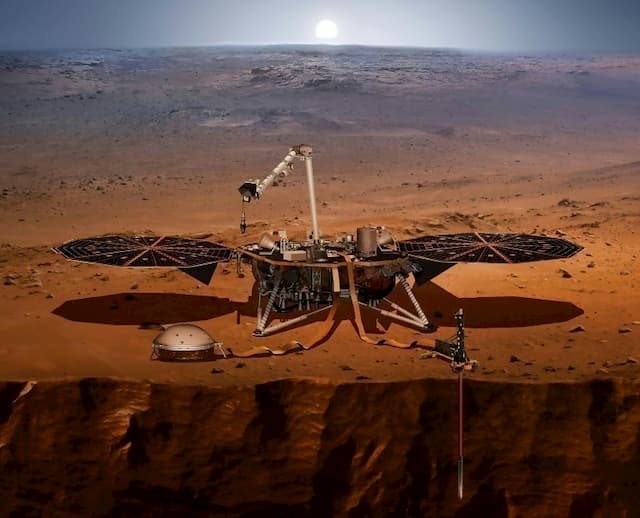During its fifteen months of presence on Mars, the device recorded nearly 500 earthquakes. So far, no tremor has been clearly identified on the red planet.
In fifteen months of presence on Mars, the InSight robot and its seismograph have already detected nearly 500 quivers from the bowels of the red planet, an abundant harvest that provides a portrait of a “living planet”, shaken by numerous earthquakes.
“It is always moving to imagine this instrument on Mars which sends us this data”, confided Philippe Lognonné, researcher of the Institute of Physics of the Globe of Paris and father of SEIS, the French seismograph embarked by InSight.
After 6 and a half months of space travel and 480 million kilometres travelled, the NASA probe had landed with great fanfare in the Martian plain of Elysium, in November 2018, allowing humanity for the first time to stick his ear to the ground of the planet.
And since then, the planet has been rather talkative. “As of September 30, 2019, InSight has thus detected 174 seismic events, of which 24 are relatively large (with a magnitude between 3 and 4), say the authors of six studies published Monday in Nature Geoscience and Nature Communication, international work involving over one hundred and fifty researchers.
If the seismic activity of Mars has already been theorized, modelled, no tremor had ever been clearly identified.
Sound files uploaded by NASA
For Charles Yana, SEIS project manager at the French space agency Cnes, “the number of these detections is quite surprising because the models did not estimate as much”.
“And since September, it continues,” notes Philippe Lognonne. The seismograph now displays on the counter no less than 460 detected events, around forty of which are most likely due to earthquakes, “earthquakes associated with playing faults”, as the geophysicist describes them.
Two of them come from a volcanic region, located 1600 km from where InSight landed, called “Cerberus Fossae” and made up of canyons more than a thousand kilometres long in which lava flowed. “In this area, things are moving in depth! “Enthuses Charles Yana.
NASA had put online in October the sound files of these two tremors (dating from May 22 and July 25), “slightly” processed and accelerated to become audible to Earthlings.
Pending a bigger earthquake
The origin of the 420 other quivers is less clear: small very superficial earthquakes, micro-landslides, landslides of cliffs… Difficult to decide. “And certain signals are complicated to understand because it is the first time that we see them,” notes Philippe Lognonné.
Anyway “these results […] reveal a living planet”, welcomes Cnes, the prime contractor of SEIS, in a press release. The data from the InSight mission provides a little more information on the composition of the red planet. Seismic waves, varying according to the materials they pass through, offer a picture of the bowels of the planet.
Scientists were able to determine that the first 10 km of the Martian crust, the result of very old lava flows, “have been altered by several billion years of geological activity, impact, or by ancient circulation processes. of water, ”adds Philippe Lognonné.
But researchers are still waiting for the Grail, an earthquake with a magnitude of 4 or more. The waves would then propagate more deeply and could give much more information on the internal structure of the planet (lower mantle and nucleus). “This is the tastiest part,” said Bruce Banerdt, InSight scientific manager at Nasa’s JPL laboratory in Pasadena, California.
Knowing the composition of the red planet will indeed help to understand how it formed and why the water of its lakes and rivers evaporated about 3.5 billion years ago.



